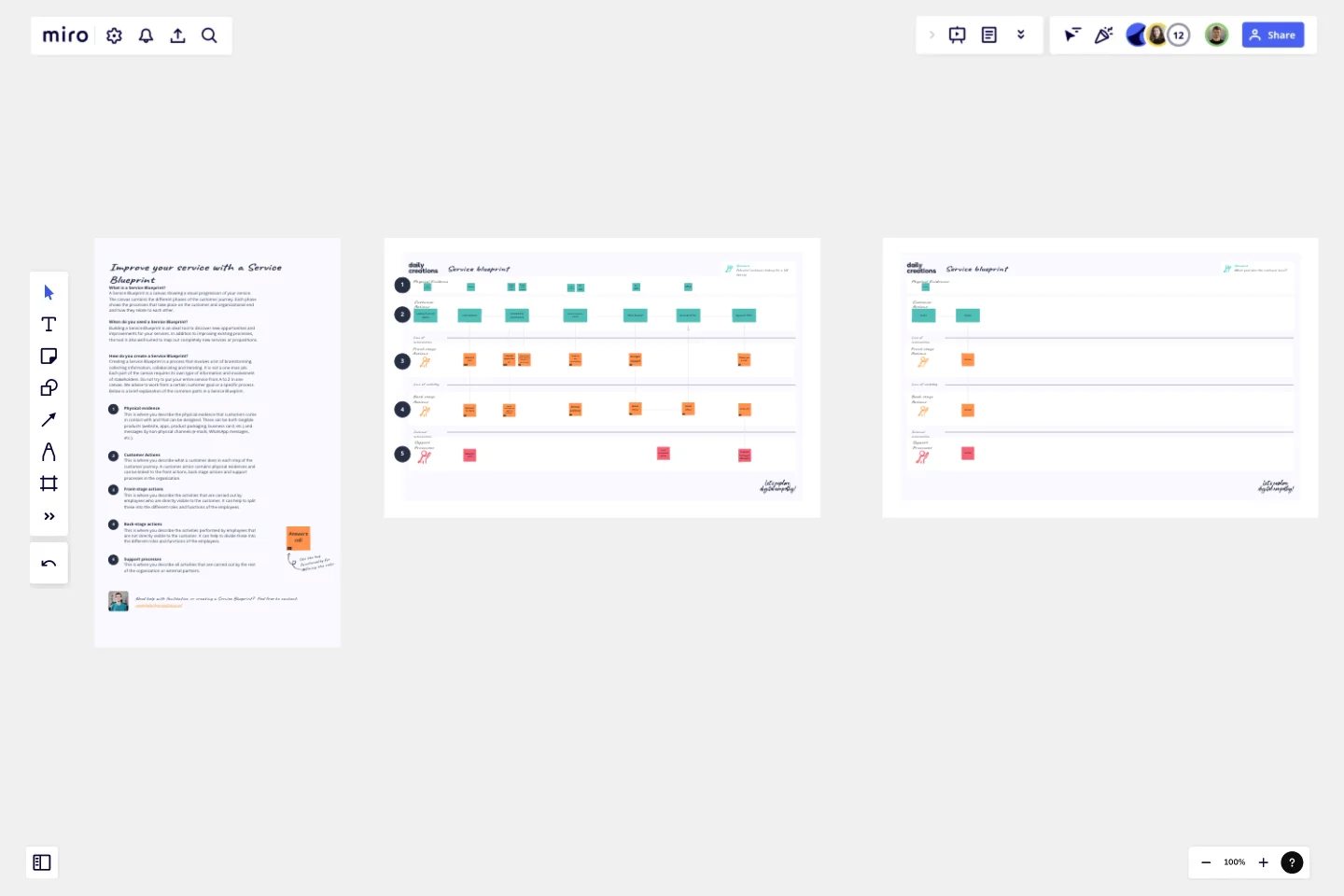Service Blueprint by Daily Creations
A Service Blueprint is a canvas showing a visual progression of your service. The canvas contains the different phases of the customer journey.
Each phase shows the processes that take place on the customer and organizational end and how they relate to each other.
When do you need a Service Blueprint?
Building a Service Blueprint is an ideal tool to discover new opportunities and improvements for your services. In addition to improving existing processes, the tool is also well suited to map out completely new services or propositions
How do you create a Service Blueprint?
Creating a Service Blueprint is a process that involves a lot of brainstorming, collecting information, collaborating and iterating. It is not a one-man job. Each part of the canvas requires its own type of information and involvement of stakeholders. Do not try to put your entire service from A to Z in one canvas. We advise to work from a certain customer goal or a specific process. Below is a brief explanation of the common parts in a Service Blueprint.
This template was created by Daily Creations.
Get started with this template right now.
Empathy Map [Research]
Works best for:
Market Research, Research & Design
Empathy Map Research template helps you gather in-depth user insights. It’s designed for teams who want to understand user behaviors and needs better. Use this template to inform your design decisions and create user-centered products.
Spider Chart Template
Works best for:
Design
Spider Charts (or star plots) prioritize thoughts and ideas by importance. They help visualize complex information with significant items in the center and less important items progressively farther from it. Radar spider charts help understand relationships between information for better decision-making.
Storyboard Template
Works best for:
Design Thinking
While storyboard is typically associated with planning out scenes for a movie or TV show, it’s been widely adopted throughout the business world. A storyboard is a sequence of illustrations that are used to develop a story. You can use the Storyboarding template anytime you’d like to really put yourself in a customer or user’s position and understand how they think, feel, and act. This tactic can be especially useful when you know there’s a problem or inefficiency with an existing process. You can storyboard existing processes or workflows and plan how you would like them to look in the future.
Rose Thorn Bud Template
The Rose Thorn Bud Template offers a color-coded approach to examining data and structuring problems. The team is instructed to approach each situation thoroughly, methodically, and analytically. They are motivated to identify a positive experience (pink), a negative experience (purple), and a promising goal or insight (green). Identifying Roses, Thorns, and Buds helps in gaining a better understanding of one's challenges.
User Interview Template
Works best for:
Desk Research, Product Management
A user interview is a UX research technique in which researchers ask the user questions about a topic. They allow your team to quickly and easily collect user data and learn more about your users. In general, organizations conduct user interviews to gather background data, to understand how people use technology, to take a snapshot of how users interact with a product, to understand user objectives and motivations, and to find users’ pain points. Use this template to record notes during an interview to ensure you’re gathering the data you need to create personas.
4P Marketing Mix Template
Works best for:
Marketing, Brainstorming, Workshops
Product, Place, Promotions, and Price. Starting with this template (and those 4Ps) you can choose the best way to take your product or service to market. The secret is to create just the right mix—deciding how much each P needs in terms of investment, attention, and resources. That will help you build your strengths, adapt to the market, and collaborate with partners. And our tool is the perfect canvas to create your marketing mix and share with teams and across your organization.
